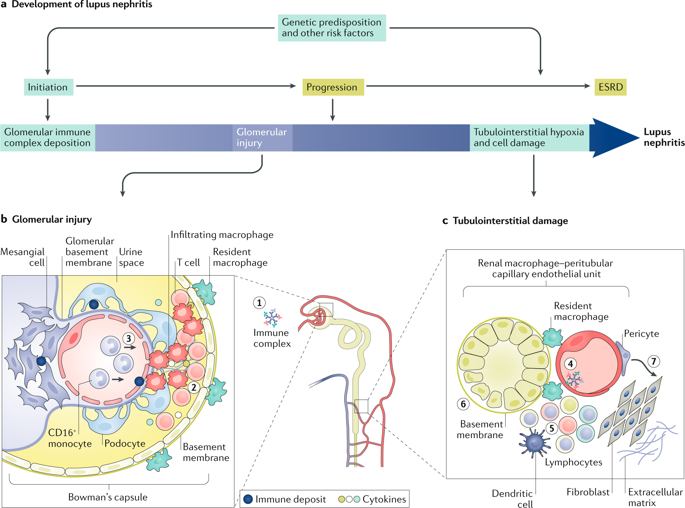当前位置:
X-MOL 学术
›
Nat. Rev. Rheumatol.
›
论文详情
Our official English website, www.x-mol.net, welcomes your
feedback! (Note: you will need to create a separate account there.)
Protecting the kidney in systemic lupus erythematosus: from diagnosis to therapy.
Nature Reviews Rheumatology ( IF 29.4 ) Pub Date : 2020-03-19 , DOI: 10.1038/s41584-020-0401-9 Naomi I Maria 1 , Anne Davidson 1
Nature Reviews Rheumatology ( IF 29.4 ) Pub Date : 2020-03-19 , DOI: 10.1038/s41584-020-0401-9 Naomi I Maria 1 , Anne Davidson 1
Affiliation

|
Lupus nephritis (LN) is a common manifestation of systemic lupus erythematosus that can lead to irreversible renal impairment. Although the prognosis of LN has improved substantially over the past 50 years, outcomes have plateaued in the USA in the past 20 years as immunosuppressive therapies have failed to reverse disease in more than half of treated patients. This failure might reflect disease complexity and heterogeneity, as well as social and economic barriers to health-care access that can delay intervention until after damage has already occurred. LN progression is still poorly understood and involves multiple cell types and both immune and non-immune mechanisms. Single-cell analysis of intrinsic renal cells and infiltrating cells from patients with LN is a new approach that will help to define the pathways of renal injury at a cellular level. Although many new immune-modulating therapies are being tested in the clinic, the development of therapies to improve regeneration of the injured kidney and to prevent fibrosis requires a better understanding of the mechanisms of LN progression. This mechanistic understanding, together with the development of clinical measures to evaluate risk and detect early disease and better access to expert health-care providers, should improve outcomes for patients with LN.
中文翻译:

保护系统性红斑狼疮的肾脏:从诊断到治疗。
狼疮性肾炎(LN)是系统性红斑狼疮的常见表现,可导致不可逆的肾功能损害。尽管LN的预后在过去50年中已有显着改善,但在过去20年中,由于免疫抑制疗法未能使超过一半的接受治疗的患者逆转疾病,因此结局在美国已达到稳定状态。这种失败可能反映出疾病的复杂性和异质性,以及获得医疗服务的社会和经济障碍,这些障碍可能将干预推迟到损害已经发生之后。LN进展仍知之甚少,涉及多种细胞类型以及免疫和非免疫机制。对LN患者的内在肾细胞和浸润细胞进行单细胞分析是一种新方法,有助于在细胞水平上定义肾脏损伤的途径。尽管临床上正在测试许多新的免疫调节疗法,但要开发改善受损肾脏的再生并预防纤维化的疗法,则需要对LN进展的机制有更好的了解。这种机制上的理解,再加上评估风险和发现早期疾病的临床措施的发展,以及更好地与专业医疗保健提供者接触,应该会改善LN患者的预后。为了改善受伤的肾脏的再生并预防纤维化的治疗方法的发展,需要更好地了解LN进展的机制。这种机制上的理解,再加上评估风险和发现早期疾病的临床措施的发展,以及更好地与专业医疗保健提供者接触,应该会改善LN患者的预后。为了改善受伤的肾脏的再生并预防纤维化的治疗方法的发展,需要更好地了解LN进展的机制。这种机制上的理解,再加上评估风险和发现早期疾病的临床措施的发展,以及更好地与专业医疗保健提供者接触,应该会改善LN患者的预后。
更新日期:2020-03-19
中文翻译:

保护系统性红斑狼疮的肾脏:从诊断到治疗。
狼疮性肾炎(LN)是系统性红斑狼疮的常见表现,可导致不可逆的肾功能损害。尽管LN的预后在过去50年中已有显着改善,但在过去20年中,由于免疫抑制疗法未能使超过一半的接受治疗的患者逆转疾病,因此结局在美国已达到稳定状态。这种失败可能反映出疾病的复杂性和异质性,以及获得医疗服务的社会和经济障碍,这些障碍可能将干预推迟到损害已经发生之后。LN进展仍知之甚少,涉及多种细胞类型以及免疫和非免疫机制。对LN患者的内在肾细胞和浸润细胞进行单细胞分析是一种新方法,有助于在细胞水平上定义肾脏损伤的途径。尽管临床上正在测试许多新的免疫调节疗法,但要开发改善受损肾脏的再生并预防纤维化的疗法,则需要对LN进展的机制有更好的了解。这种机制上的理解,再加上评估风险和发现早期疾病的临床措施的发展,以及更好地与专业医疗保健提供者接触,应该会改善LN患者的预后。为了改善受伤的肾脏的再生并预防纤维化的治疗方法的发展,需要更好地了解LN进展的机制。这种机制上的理解,再加上评估风险和发现早期疾病的临床措施的发展,以及更好地与专业医疗保健提供者接触,应该会改善LN患者的预后。为了改善受伤的肾脏的再生并预防纤维化的治疗方法的发展,需要更好地了解LN进展的机制。这种机制上的理解,再加上评估风险和发现早期疾病的临床措施的发展,以及更好地与专业医疗保健提供者接触,应该会改善LN患者的预后。































 京公网安备 11010802027423号
京公网安备 11010802027423号